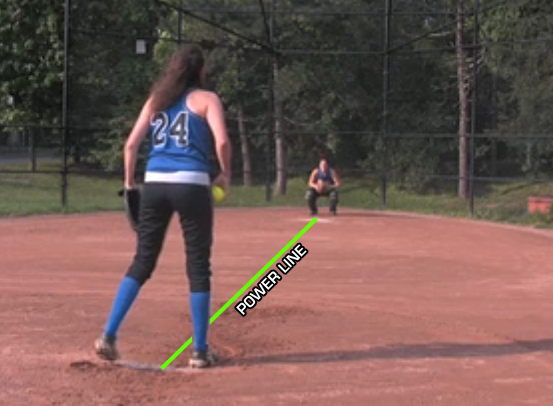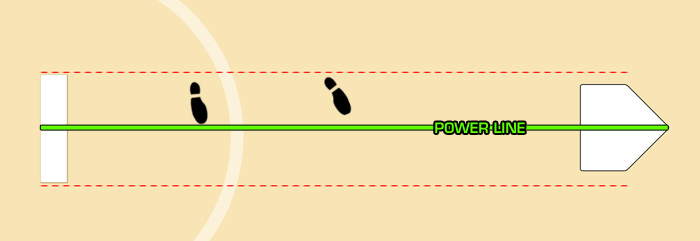Should the Stride Foot Land on the Power Line?
The question of landing on the power line has come up a couple of times now among Fastpitch Power readers, so I want to share my response with all of you. Many people assume that to throw a strike as a windmill pitcher, you want to land on the power line—sounds right, doesn’t it? Well, it’s not quite right. Today we’ll discuss more specifically where you SHOULD be landing.
NOTE: What we’re going to discuss today DOES NOT APPLY to curveballs and screwballs. We’re only going to discuss the fastball, but the same concept will apply to the change-up, rise, and drop as well.
Refresher: What Is the Power Line?
The power line is an imaginary line on the ground (or a real line—feel free to draw it if you’re a beginner!) that goes from roughly the center of your body as you’re standing on the rubber facing your catcher right to your target (below the catcher’s glove). Here’s an illustration of it:

When you reach, both arms and your stride leg should be lined up over the power line. When you track, your pitching arm should follow a circle that is always over the power line, your glove hand should remain over the power line, and your drive-through foot should move to the power line (naturally…don’t hop there!) and begin dragging along it. When you fire, your pitching arm—and thus, the ball—should travel down the power line. For a more in-depth look at reach-track-fire mechanics, watch this video.
Where Does the Stride Foot Land?
You’re probably thinking, “On the power line!” Well, not so.
One of the most important factors in throwing a strike is making sure your pitching hand is always over the power line. If your stride foot lands on the power line, it means your whole body is perfectly ON the power line.
If your body is ON the power line, your pitching hand CANNOT be on the power line. Unless you’re a ghost and you can throw right through your butt, your body will be completely blocking the clear path of your arm over the power line. Your arm will swerve around your body rather than accelerate straight past it, robbing you of power and accuracy.
So where DOES the stride foot land? About 4-6 inches off the power line to the left if you’re a righty, or to the right if you’re a lefty. This leaves plenty of room for a nice clear throw zone. For a more detailed explanation of body positioning and the throw zone, watch this video.
If I’m Landing on the Power Line, How Do I Fix It?
My recommendation is NOT to pay attention to the spot your foot lands. Focusing on this is not a productive way to visualize a pitch with power and command. Instead, focus on your throw zone. Imagine your throw zone as a runway that really exists, make sure you point it at your target, and make sure your hand fires down that runway.
If you’re having trouble visualizing the throw zone, pitch near a wall, net, or fence. Stand facing your catcher with your pitching shoulder a couple of inches from a wall and pitch. Believe me, you’ll notice if you’re blocking your power line because there won’t be enough room for arm to get through! If you’re doing it correctly, there should be a perfect lane between your body and the wall for your arm to fire through. Make sure your catcher is wearing full protective gear. You may hit the wall with the ball the first few times and your catcher may not be able to catch unexpected deflections.
To break it down further, make sure you do your warmup drills (such as isolated arm circles) in power position. Stand tracked to your catcher with your drive-through toe touching the power line and your stride foot 4-6 inches off the power line, then do your arm circles. Here’s a diagram of where your feet should be in power position:

Notice that the stride foot is angled at about 45 degrees to the power line.
As always, leave any questions in the comments!
You write your drive-through foot should move to the power line naturally. Where do you teach your students to place heir power foot at the beginning of the pitch and why?
Thanks for a reply.
To be totally honest, we don’t fuss over it unless the pitcher for some reason is placing her foot on such an odd part of the rubber than it’s causing her trouble. We have our pitchers start with their feet a comfortable width apart, and some merely push from there while some prefer to do a “slide step,” where they slide their push foot from the outer edge of the rubber to closer to the center before they load. So it varies slightly from person to person.
Realistically, in many cases it will also be determined by the field. There’s often a big hole where most pitchers put their push foot, and on many fields filling it in is difficult and starting in any other spot is uncomfortable. So the pitcher should have some ability to adapt without feeling too uncomfortable when it comes to foot placement.
Carly, when the plant foot lands, where should the ball be in the windup. Is the pitcher pushing off against that plant foot?
When the plant foot lands, the ball should be between 12 and 10 on a clock (over the head or moving slightly down the back of the circle). The plant leg needs to be VERY strong; it’s job is to rapidly stabilize the body and transfer all the energy that’s coming forward back into the pitching arm. In many girls this may make them feel like they’re pushing into it.
You talked about the stride foot location for a fastball on the power line but, what about the stride foot location for a curveball or screwball, and why would it need to be different?
James – The stride foot location, on landing, should ultimately be substantially similar from one type of pitch to the next. I like, in younger developing pitchers however, to accentuate the establishment of front side resistance along with a throw-zone that is shaped correctly for that particular pitch. I have found, over the years, that exaggerating an offset in the landing position of the stride foot for developing pitchers helps them to more consistently establish the desired front side resistance along with the correctly shaped throw zone. For a curve ball, the right hand pitcher will cross over the power line perhaps 3-4 inches to accomplish this. For a screw ball, she will stride 3-4 inches farther to the left of the power line than her typical fast ball stride. As the athlete becomes more developmentally advanced, the variation in the landing position will generally become less and less as her hand speed, forearm fire, and snap become stronger. I hope this clarifies the issue. Please let me know if you have any further questions.
Phil